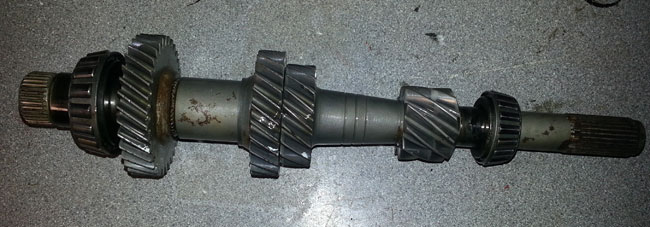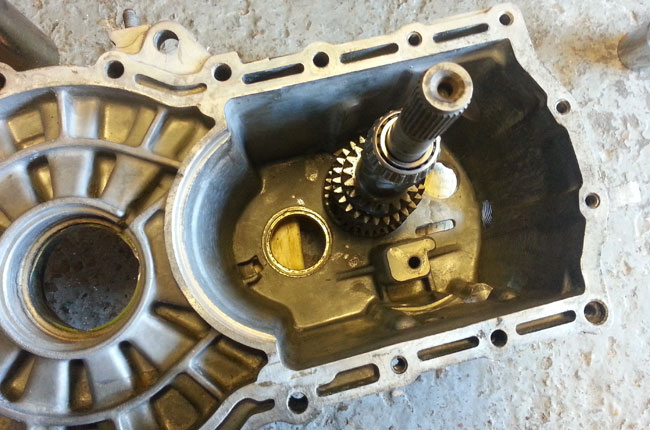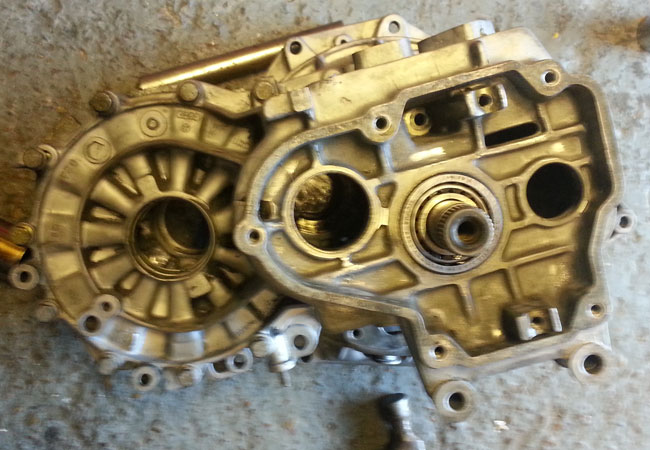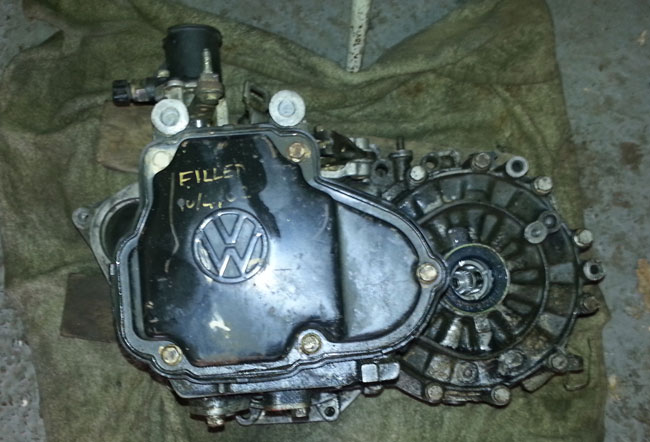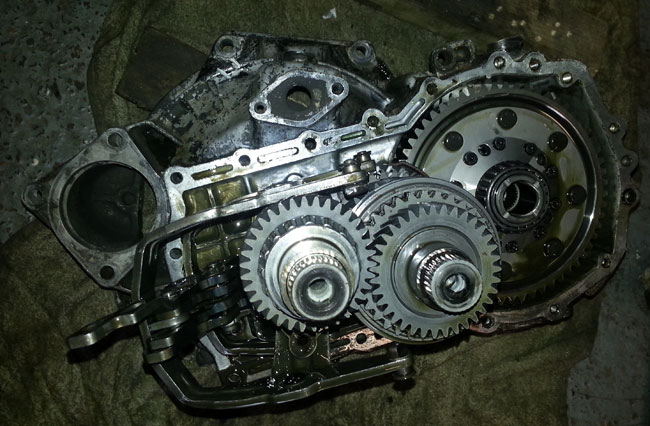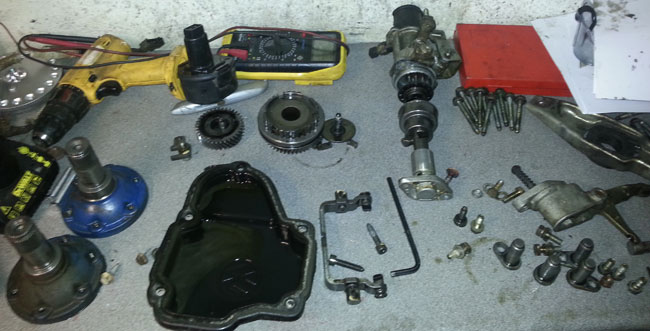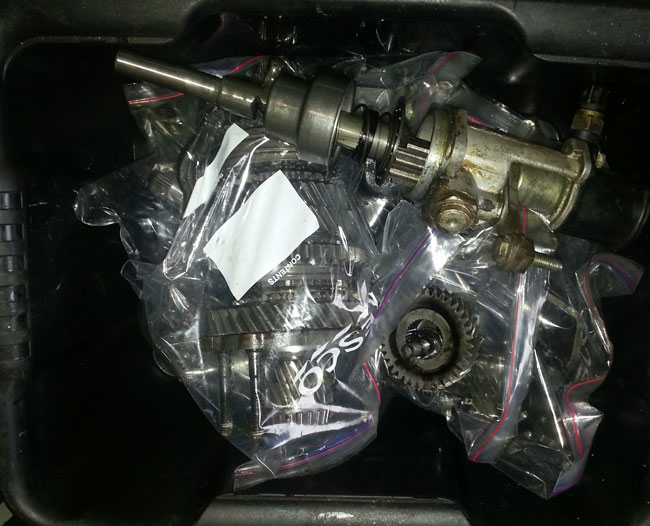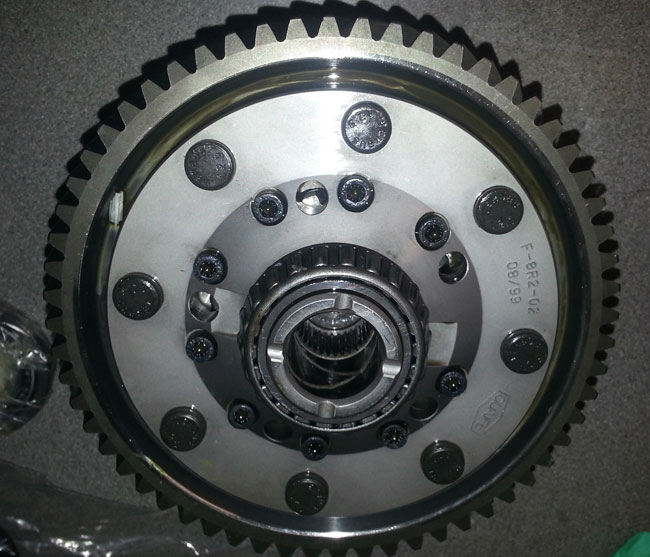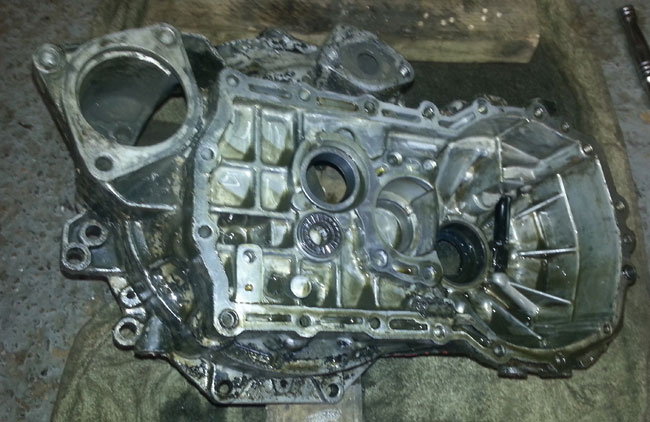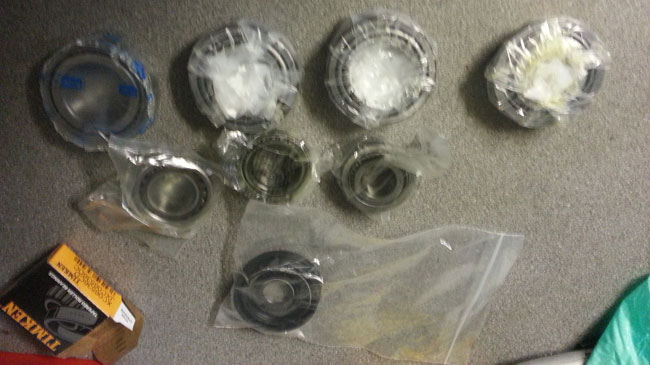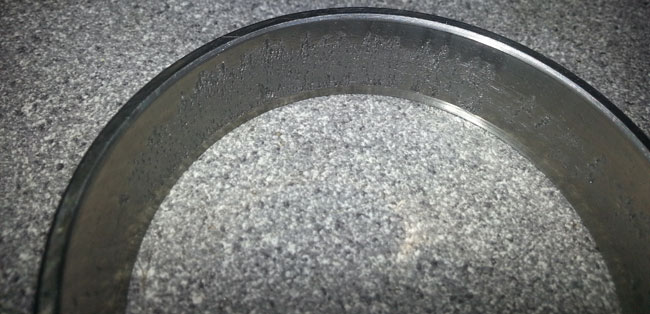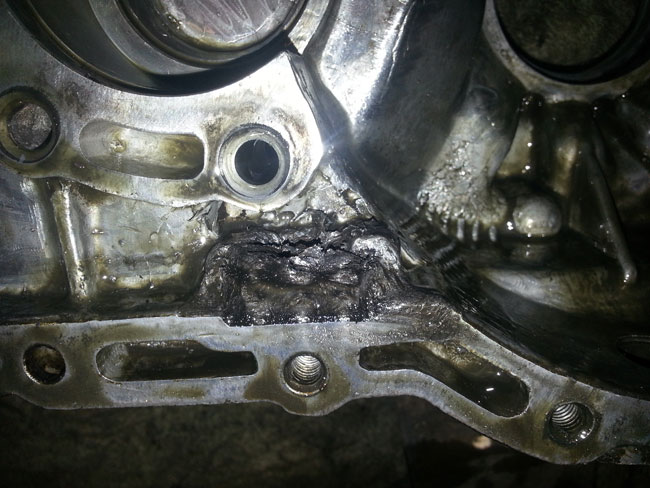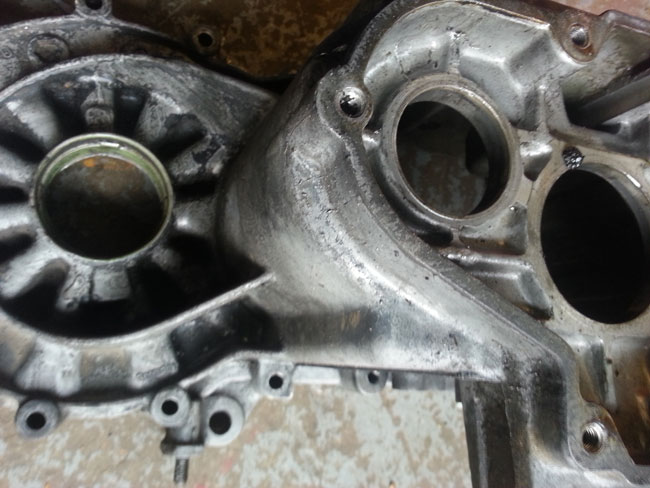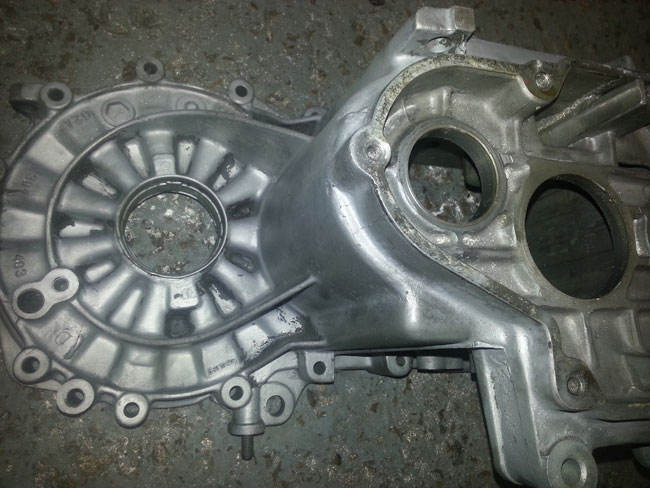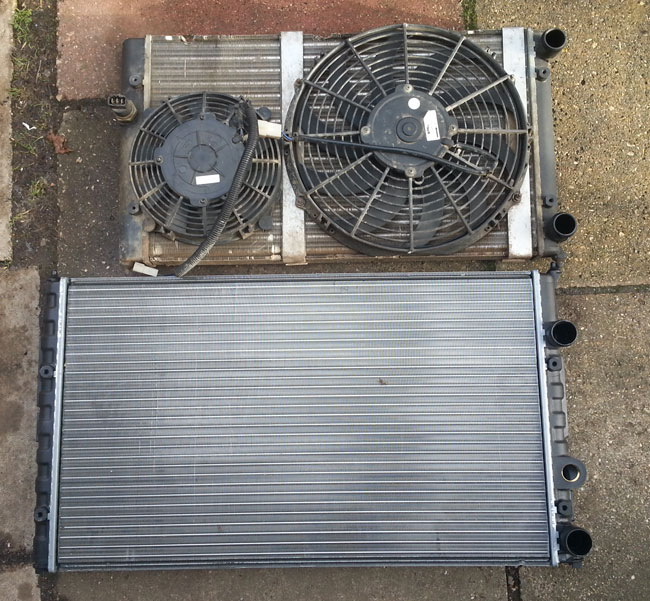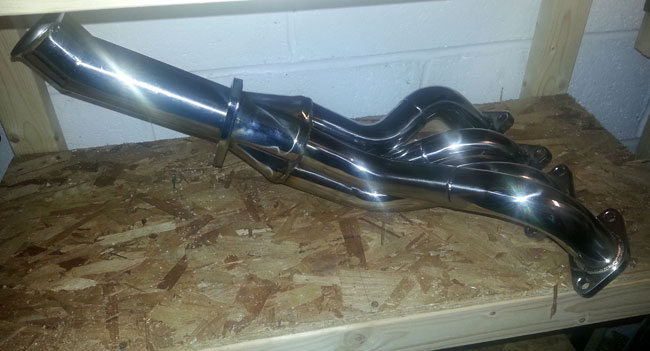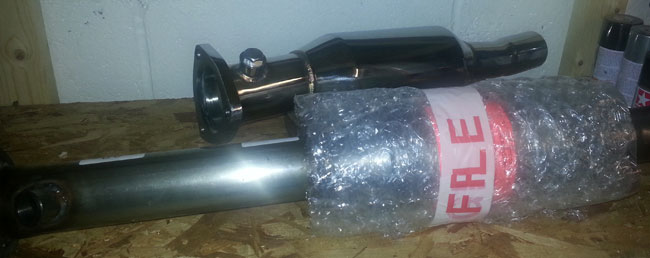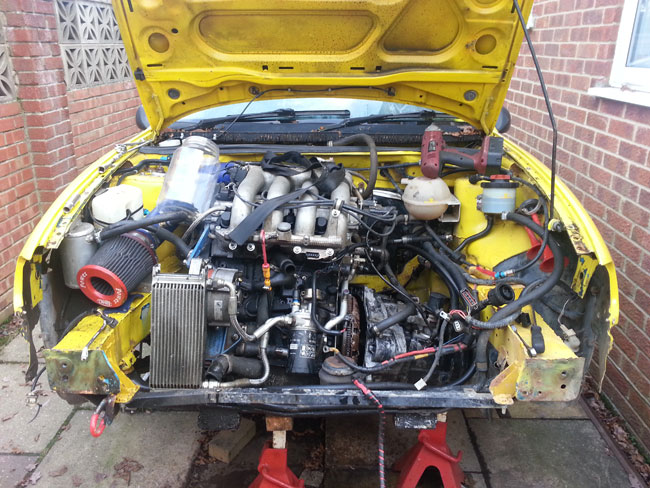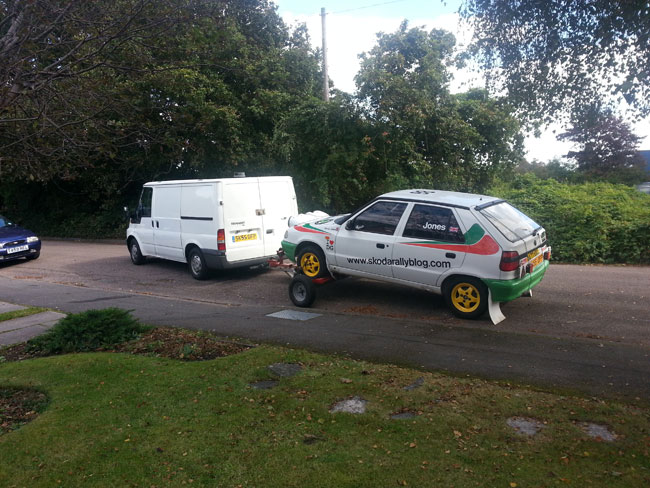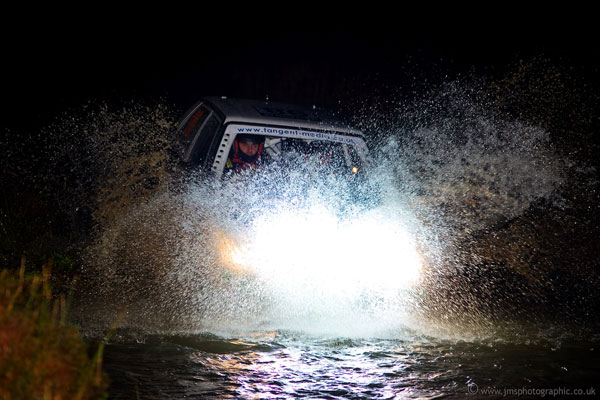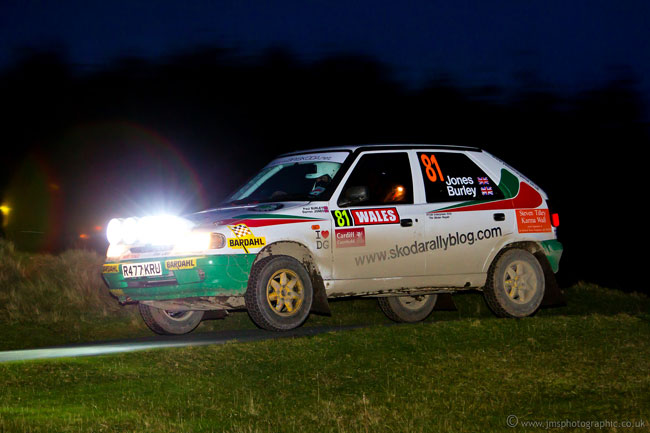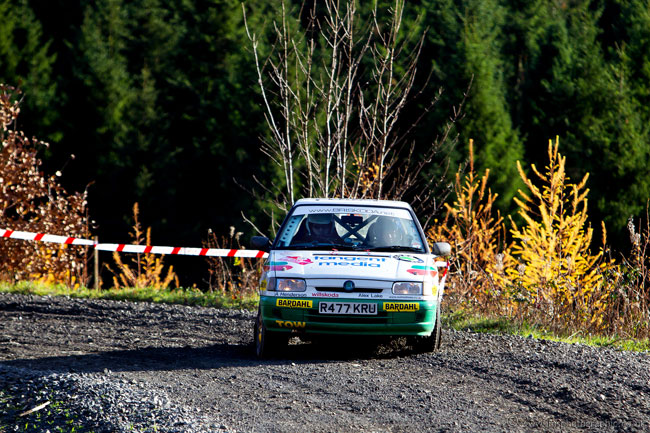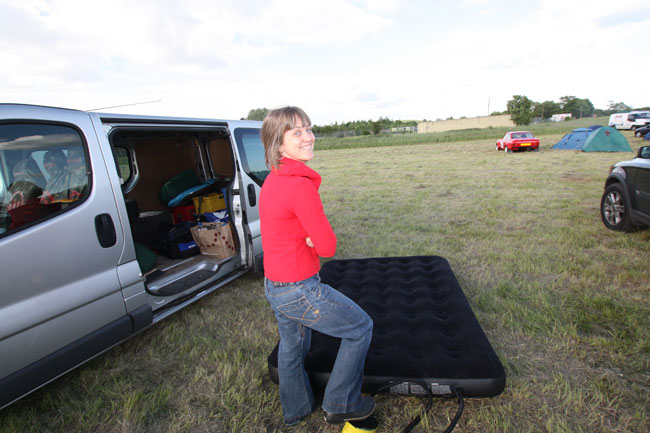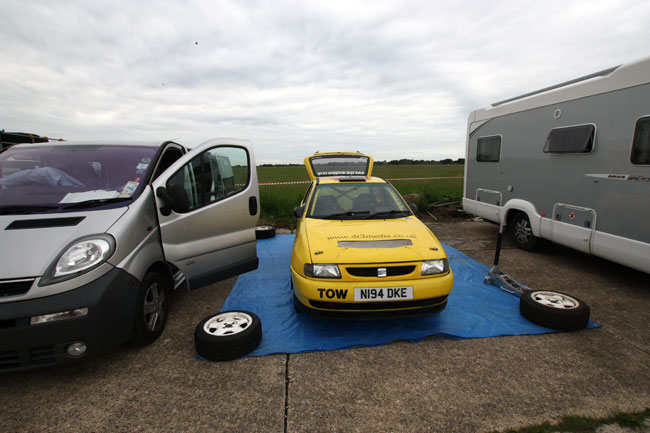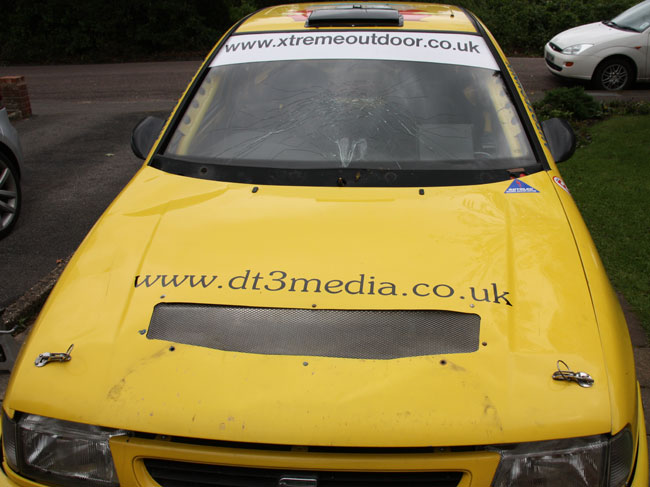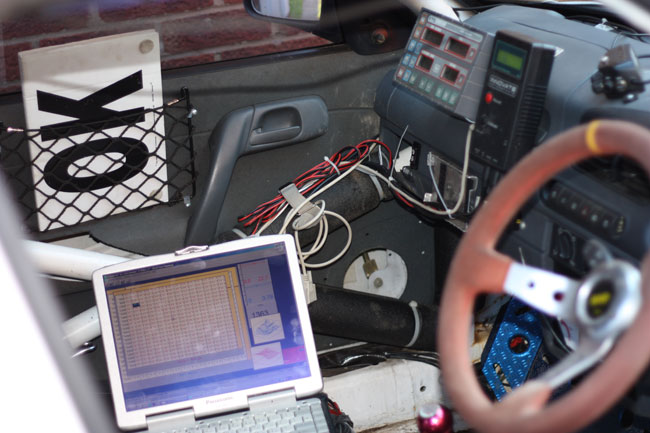Build
Gearbox fun
by Darren on Mar.05, 2013, under Build
OK, so last weekend I’d stripped the box and cleaned up the cases, but now it’s time to get serious. Firstly, the old ATB diff has been stripped of the crownwheel and bearings and put on eBay, so if you want one for an O2A box (fitted to a huge range of VAG group cars) then head over there to get yourself a bargain as they’re bloody expensive new!
Looking at the gear cluster, the ratios that are in there are the best choice from the standard sets available, and what is nice is that the final drive is a 4.61, meaning the car is geared much lower than standard overall – this looks to be an expensive item from the brief search I’ve made of online sellers of such stuff – around the £600 mark! I’d really like a close ratio setup as I had in the Skoda…. but the problem is that the only kits I can find are north of £1700, which is not an option at present, so it’ll have to stay standard.
Now, time to rebuild the box. Looking at the old bearings, all of them look heavily worn, possibly because they weren’t set up correctly – they all look to have suffered a lot of heavy load, and while not as bad as the diff bearings, they were all in need of replacement. Setting up the box is a case of installing new bearings to a shaft, fitting the bearings into the case, and then measuring the end play of the shaft. This measurement is taken with the desired clearance (sometimes a negative clearance so the bearing will be under some pressure), and then the appropriate shim is purchased. The input shaft was first up, so old bearings pulled off:
And then new ones fitted, and the shaft popped in place:
Next, the casing was fitted and bolted up to the correct spec, and the end play in the shaft measured.
Using the manual from VW I now know the correct shim I need for this shaft…. the problem I have is that I can’t go any further with the box now, for three reasons. Firstly, the next shaft needs a shim placed in one of the bearing housings to allow it to be removed (it’s in a blind hole, and without a shim behind there would be no way to remove it – it was a pig even with one in there). So I need to order that. But more importantly, I need to get a tool made up and a press to allow me to disassemble this shaft as it has three bearings, one of which is installed behind all the synchros. Once they’re all off I can set this bearing pair up and measure that.
The diff from Gripper…. has been ordered, but they are waiting for parts to arrive, so once they have them, I’ll be relieved of a load of money, and then I’ll have a diff that I can install and do the same procedure on as the other shafts. It’s just one of those jobs that will take a bit of messing about as there are several stages and special tools needed, alas! Still, it’s getting there… slowly.
Gearbox stripdown
by Darren on Feb.24, 2013, under Seat
Aside from wanting to change the Quaife ATB diff for a plate one, there had always been a problem with the Ibiza’s gearbox, and that was that it was very noisy – it sounded like a bag of ball bearings, in fact. The synchro on second gear was always a bit lazy (not helped by my poorly co-ordinated gearchanges on gravel!), so that would probably need replacing too. Now it was actually out, it was time to strip it down – something that I’d done some reading up about, and was a little concerned that there would be some potential problems on the way. Anyway, here it was, ready to come out.
Stripping the first casing off was straightforward, but behind it was the pair of gears for 5th gear, and this was the potential problem – I’d read a number of horror stories about people chipping the gears, and I really didn’t want to do that; this meant being really careful and modifying my puller to get into the 1.5mm gap behind the gears. Out with the grinder, spent about 10 minutes getting it into shape and while trial-fitting one of the legs, I pushed it in…. and the gear moved! This was really good news as one of the gears came off without any issue at all. The news got even better when the other one came off just as easily. Splendid. Now it was just a case of undoing another 6 bolts for the inner gear pivots and then all the case bolts, and then…
… all the insides were revealed. All looking good, and easy enough to strip down further – it looks a very sturdy box, and is far easier to take apart than the Skoda box was. There’s more work to set it up (both shafts and the diff need to be set precisely), but it will be much easier to put back together once that’s done, thankfully. Here are all the bits that had been removed:
Driveshaft flanges, casing, 5th gear pair, selector, pivots and clutch actuator. All easy enough. They were bagged up, and then it was time to remove the gears and the diff, leaving me with a box full of bits:
And also the Quaife ATB diff, which I will sell to help fund the purchase of the gripper plate-type diff.
Now I had a couple of empty casings, which needed to be cleaned up properly.
This is not just for cosmetic reasons although the gearbox was painted at some point, badly and with some terrible paint, so it looked awful. When I did this with the Skoda gearbox, it also had the benefit of making it far more corrosion proof – it didn’t look bad after 3 years of use, so I’ll do the same with the bead blaster. All I needed to do was remove the bearing races, as I have a new kit of bearings to replace the old ones – some of them are unusual, so the 7 bearing kit cost a rather pricey £100:
On removing the bearings, the reason for the noise became apparent – the diff bearings were about as knackered as any I’ve ever seen. I think the diff bearings may not have been set up properly, having too much load on them, leading to this:
That bearing race should be perfectly smooth, and even in the rather poor photo above, you can see it’s anything but – both bearings were badly damaged, and this alone would have made it sound horrendous. This damage was confirmed by looking at the magnet in the gearbox that is there to retain the (inevitable) bits of swarf that are in a gearbox during its lifetime as the parts wear:
It was completely covered in the stuff, mostly bits of the bearings that had broken up. Next up was the lengthy task of cleaning up the cases, both inside and out. Lots of cleaning, then bead blasting meant that this:
Ended up looking like this:
It’s not perfect as my blasting cabinet is too small to be able to get to everything, but it’s way better than it was before, and also means it could be examined properly for damage, and thankfully none was found.
In other areas, the new (much larger) radiator was fitted today. The fitting really just meant moving the mounting bar down by 60mm, which thankfully didn’t mean any other changes. The radiator slightly obscures the oil cooler, but I will make up a duct to stop the air from the radiator passing by the cooler, and open up some space in the front panel to improve airflow to it. Here it is, fitted:
As you can see, it’s MUCH bigger than the original (about 1.4 times the area), so it should do the trick. A long day’s work, but at least the car is moving in the right direction. I’ll be ordering the LSD this week (no, not the drugs, although the thought has crossed my mind!), and hopefully making some progress with the driveshafts.
Spot the difference
by Darren on Jan.27, 2013, under Seat
So, last time out, I’d just discovered that the Ibiza’s current radiator was much smaller than it should be. A bit of time spent looking on various online catalogues only increased the mystery, however, as the standard size of the radiator wasn’t immediately obvious – there were a few different sizes listed by manufacturers, some different by car spec, others just different anyway – for the same year and spec of car, the sizes were different! Looking on VAG-CAT (a site with original microfiche info on it) opened the can of worms further as it listed even more sizes, one of which was very much larger than the current one. The front end of N194 DKE has been modified with a support bar for the radiator, so I’m not sure how it would have originally sat, but I found one of the largest size radiators on eBay for only £40, so I thought I’d order it and see what gives – it’s not the end of the world if I can’t make it fit – and this thinking was reinforced by the quotes I had for bespoke radiators which were around the £500 mark. As a wise rally bod said to me – “That’s OK, but you need two as if one breaks you’re stuck”, and with that in mind, I think modifying the car to suit a standard rad is a better idea, especially if they are £40 a throw. I had worried that a wider radiator will obscure the oil cooler, but even the new, massive one doesn’t do this – the end tank is slightly in front of the edge of the oil cooler, nothing more. The bar that supports the radiator will need to be made again, but that’s OK as a) it’s a simple piece of steel tube with flat brackets on and b) it’s bent anyway.
Anyway, that’s about as much as I’m capable of this weekend, I’ve had flu (yes, proper flu!) all week, and feel as weak as a kitten, so here’s a picture of little and large to be going on with. Next weekend, with any luck, I’ll get the engine out and get to the gearbox at long last!
Well, that’s one mystery solved…
by Darren on Jan.14, 2013, under Seat
… as said the other day, the Ibiza has always overheated – well, not overheated, but run very hot and when used on gravel, definitely overheated – on the Sunseeker the temperature gauge was always far too high for my liking.
And I’ve just found out why! I said I thought the radiator looked a bit small. It is. From the part number, it’s intended for a 1.8 Golf MkIII. With a (maximum) 66kW engine, which equates to 90bhp, give or take. And given that the Ibiza is generating about twice that, I think this may be why it was running hot! Unfortunately, it looks as if the solution will be a bespoke radiator as the space available is somewhat limited by the presence of the (also necessary) oil cooler.
New Beginnings
by Darren on Jan.13, 2013, under Seat
So, it’s been a few months since the last entry on here, and that’s been for a number of reasons – firstly, getting over selling the Skoda – not only because I sold a car that I spent a lot of time and money building, but also because it represented the end of a chapter for me, the possibility of doing Rally GB (or indeed any other sizeable International event), which took a while to take in and see what I did in the past for what it actually was – a great achievement and something that very few people are lucky enough to get the chance to do once, let alone four times.
Secondly, I decided to make up for selling the car buy realising a boyhood dream, and buying a Porsche 928 with the money. Yesterday I sold that car, and while I’m glad I bought it and don’t ever have to go back there again, it didn’t work out in the way I’d have liked; so many things suffer from ‘reality shortfall’ and the 928 was definitely one of those. The car wasn’t a dog by any stretch of the imagination, but it wasn’t the dream car I’d hoped it would be.
Thirdly, I’ve just been really busy with everyday life, working and spending time with Tammie and the kids, so I have less time to spend in the garage.
Fourth, Rallye Sunseeker has been moved to October 2013 (instead of the usual February), so there hasn’t been any real pressure to get the car done; at the time of finding out about the move it was just about a year away, which made it seem incredibly distant. Combined with wet weather this meant nothing really has been done.
Now, however, it’s time to get on with it, so I’ve made some progress today on getting the car ready. The first thing is that the gearbox needs to be rebuilt – it sounded like a bag of spanners when I got the car, and that didn’t get any better over the three events I drove it on. According to the manual, this should be a fairly easy thing to do, but there were some issues; firstly I couldn’t get the sumpguard off! Two of the four bolts that hold it in place were solid; no idea why as they were all greased when fitted and all bought at the same time and fitted to the same torque, but there you go. And as they are recessed allen bolts, removing them was not straightforward. Fortunately welding bolts to the heads got them free in the end, but it was a lot more work than it needed to be!
Now, according to the manual, it should be possible to remove the gearbox leaving the engine in situ, but after an hour or so of trying, it became apparent that this is not the case – it just wasn’t possible to do it as the subframe was in the way no matter how I tried, so the whole lot needs to come out; this will give me a bit of a leg up with another issue as the exhaust manifold isn’t something I’m happy with, so I’ve decided to change it to something better, and also replace the catalytic converter as it was on its last legs at the last MOT and I’d really like a car that I can MOT anywhere, anywhen as the MSA are clearly becoming far more on the case with things such as emissions. To that end I have bought this little beauty:
It will need modification to fit (probably a fair bit), but it’s a good starting point, and it was a bargain at just £72 brand new. I’ve also bought a new cat and bypass pipe (to allow mapping without killing the cat):
So hopefully all of that will make life much easier. In addition, this was all spawned by the incredibly difficult fitting that was done before, so I’m hoping that the modifications will allow it to be fitted to the car with the engine in situ as it was difficult and painful fitting the old downpipe when the engine was in place.
This aside, it was time to get everything ready to get the engine out. Fortunately the Ibiza’s front end has a bolt-on front panel, so access to everything is much easier once that’s out the way.
The coolant radiator needs beefing up as the car was nearly always running hot when used on the Sunseeker, so I’m going to give the whole cooling system the once-over, but the radiator seems tiny to me – it’s about the same size as the Skoda one, and that’s for a car that has one third the power as standard. Clearly something’s not right.
A couple of hours’ work left the engine bay stripped and pretty much ready to go, but there’s other stuff in the way in the garage at the moment so I’ve decided that waiting is the best thing to do – hopefully I can get the engine out next weekend, and then start working on the gearbox in the evenings.
In other areas, the driveshafts I ordered in June (no, really!) are still ‘in progress’ so I will chase them up – I did so over Christmas, so hopefully this time I’ll actually get them soon. I’m going to get rid of the ATB diff and fit a gripper to the car as I think this will help out, plus also find the cause of the uneven camber that has plagued the handling – with the engine out it should be much easier to make accurate measurements and find out what’s adrift (and get it fixed). There’s also a new cylinder head to go onto the engine, which should see it making more like the 200bhp I’m after, so there’s plenty in store, aside from fixing all the nasty little bodges that I’ve found today on engine brackets and so on!
The last post…
by Darren on Oct.01, 2012, under Skoda
On Saturday something happened that I said never would. Today I sold R477KRU. To be fair, it had been coming for a while – not only when I’d made the decision, but it had been clear since buying the Ibiza last year that one or the other would have to go, and despite N194DKE’s rather poor reputation (3 starts, 3 DNFs, two due to mechanical failure, one due to sister failure), it has shown itself to be potentially a far better car than the Felicia ever could be; without major surgery (i.e. a replacement engine and gearbox) the Skoda would never be able to match the Seat on power, and many other factors were in its favour. But I loved the Felicia, partly because I built it (and since I was a teenager I always wanted to build a “good” car, the definition of which really became a car that would finish a long rally), and partly because of the memories it held; while WRGB 07 was an unpleasant experience in some ways, 08 and 10 made up for it in droves. But it had to go.
First up on the day, getting everything ready to go. This was no mean task in itself – there were a LOT of spares that I’d collected over the last 7 years of running a Skoda, with loads of wheels and tyres making up the vast bulk of it, but in addition lots of spare parts which I’d bought at the right time or when I’d been bored on eBay of an evening. Either way, there were boxes of parts, alternators, pipes, starter motors, hubs, wishbones, all sorts. All of them needed to be sorted out and boxed, which took a couple of hours, and meant the garage was pretty full, and there were five stacks of wheels and tyres in the back garden. On the upside, the shed where I have all the bits had shelf space available for the first time in years. Makes you think how much time, effort and money you’ve put into something when you see such a massive amount of stuff, though – nearly every eventuality was catered for with the amount of parts there.
I then needed to get the car started, and it hadn’t been for a month or so. It was a bit reluctant to start, but fired up in the end and was ticking over nicely in a couple of minutes. Lewis (the buyer) was unable to come and pick it up, but sent his friend Ian to do all the hard work instead, so when he arrived around lunchtime he had a van and a towing dolly and a fair bit of work to do. I wasn’t sure that everything would fit in the van, and as it turns out, I was pretty close – boxes of lightweight parts needed to go in the back of the Skoda, but we filled the van with the massive spares package (over 30 wheels and tyres) that came with it, and it took an hour or so of solid work to get it all done and loaded up.
Finally it was time to get the car loaded up onto the dolly to be towed away, and it went on without any major fuss, reliable and straightforward to the end. I put the keys back in the ignition and stepped out, the last time I’d ever drive it, quite a sad moment when I thought about all the other times I had been behind the wheel, but I guess that’s progress for you! Ian strapped the car in place safely, sorted out the tail board with lights on, and then it was time for him to set off. I stood in the front garden, looking a -bit- like a mad man as I watched the car go, taking a few pictures as it went:
And that, as they say, is that. A 5 year long ownership of the car (the longest of any car or bike that I’ve ever owned) comes to an end, and hopefully it’ll be off to do some more interesting events in the future – certainly if Lewis’ plans come to fruition then it will see some more interesting events. In the meantime, here are some final pictures of the Skoda on Rally GB, courtesy of Jon Suter – www.jmsphotographic.com.
A tough decision.
by Darren on Aug.30, 2012, under Skoda
So, despite a number of promising leads, no navigator was forthcoming for Rally GB 2012. This is double disappointing because as you will know, the Felicia will no longer be WRC-event eligible from the end of this year (unless the FIA extend it again, of course, but given that it should have finished in 2008, it’s unlikely). And at the moment in the drive I have not only the Felicia, but also the Ibiza, and this is not a state of affairs that can last too long – insuring both vehicles is expensive, and of course I can’t afford to keep both long term. The entries for Rally GB closed a couple of weeks ago, and I’ve been away on holiday since then.
However, a decision needed to be made – which car to keep. Both cars have their upsides – the Skoda is a car I built myself, with a great cage installation, with a shell that is in excellent condition, with an engine that’s strong for an 8v 1300, and has a great gearbox and diff. And most importantly, it has a set of Proflex suspension on it which is very low mileage (as all the internals were replaced when I had it rebuilt in 2009), and transforms the car – it’s the same step forward as a close ratio box is. The Ibiza has upsides – it’s a really well built car, with a lot of neat features. It has plenty of power, and the expensive bespoke 2 turns steering rack. Both cars have downsides, however. While the Skoda is quicker than it ever has been before, it’s not as powerful as the Ibiza. The brakes are not in the same league as the Ibiza’s £2000+ AP racing setup, and it has been built to homologated spec which is now expiring for WRC events (but still valid for other internationals for another 4 years) and the chances of me doing another International event are vanishingly small. The Ibiza has limitations – it needs a fair bit of fettling (cooling issues, driveshaft breakages), and the gearbox, diff and suspension are not to the same standard as the Felicia. But it has real potential.
Clouding all this is the fact that I built the Felicia. I’m not prone to sentiment for the most part, but when I was younger and started meddling with cars, I always said I wanted to build a car that would be ‘good’ (yes, I was that vague). And I built the Felicia in 2007 with the aim of completing Rally GB, which of course it didn’t due to an air filter breakup. It returned in 2008 for a near trouble-free run, and in 2010 it had a few troubles, but managed to complete the event, so I feel that I’ve built a decent car that is tough and quick enough for what it is. And it would be hard to let that go – anyone who’s seen Eric Bana’s excellent “Love the Beast” will know what I’m talking about here. Further complicating the decision is that I’ve never finished an event in the Ibiza; the Sunseeker was close, but not a finish, and as a result I don’t feel that we’ve “bonded”.
But I think that all things considered, the decision needed is to keep the Ibiza and sell the Felicia, so to that end I have been thinking about what to do to improve the Ibiza. There are three main issues for me; I’m sure that with new, stronger driveshafts that bugbear will no longer be a problem, but suspension, gearbox and diff are definitely in need of attention. When selling the Felicia, I would definitely not sell it with the Proflex on it; it’s more valuable to sell on its own, and I have a perfectly good set of Bilstein suspension in the shed ready to fit to the Felicia to sell it. And a bit of quick measuring up showed something quite remarkable; the rears would fit onto the Ibiza with only minimal modification being needed; just a top mount spacer (from the Ibiza’s original setup) would need to be modified by drilling it out (it was threaded originally), and the rear just bolted up. The fronts would need more work, as they are a completely different fitting, but interestingly it looks possible to make a bolt-on adapter which the strut would sit in and then have lugs for the Ibiza front hub to bolt to. I am drawing this up this evening to take to get a price for them to be made up, and then I will see how it goes from there.
That left me with the task of getting the Felicia ready to sell. First up was a review of the spares that come with the car. And there are a lot. No, really, it’s amazing how many parts I’ve bought over the 6 years I’ve had a Felicia. I’ve got 28 Gravel tyres (good ones), 8 tarmac tyres, most of which are on wheels – enough to keep the next owner rallying for a couple of years (if not more). I think that’s about £1200-worth of wheels and tyres alone, let alone anything else. There are loads of bits to keep the car going, I reckon it would be possible to use it for a few years without spending much money at all, plus parts to build a 1.4 bottom end should the next owner want to go down that road.
Anyway, aside from that, I have done all the work needed to get the car ready to sell – that involved a damn good clean first, which took a few hours, but it’s looking nice and shiny. Next up was fixing a few things that should have been done a while ago, and also replacing parts which were past their sell-by dates. The car has a new set of Titon harnesses fitted, a new set of front brake discs, and the front brakes serviced as the sliders had become a bit sticky. Brake fluid was changed and re-bled, and a new sensor fitted for the Terratrip. The Peltor intercom is not going with the car, but pretty much everything else is, and it’s all nice and clean inside and out now; with new extinguisher pull fitted it’s ready to rally, give or take.
The car has been advertised for a while and I had some interest while I was on holiday, although the first serious purchaser wanted the spares freighted up to them in Scotland, which wouldn’t have been possible, but I have someone else seriously interested who has been asking the right kind of questions and seems to be serious about competing in the car and giving it the future that I wish I had the time and crew to do so – taking the car abroad to Ypres, for instance. Hopefully this will pan out and the car will be off to a new home in the next couple of weeks.
Abingdon Car-nival
by Darren on Jun.11, 2012, under Seat
This weekend was an unusual one. Firstly, because I was doing a tarmac event – as a driver, other than Christmas with my sister, the first one since 2005, I think – certainly since 2006 when Rally GB took over my rallying for each year (or more to the point, my entire disposable income for the year!). And secondly because my navigator was to be my girlfriend, Tammie.
Tammie has no interest in cars whatsoever – they are a form of transport for her and nothing more. She knows nothing about motorsport, but wanted to see what it’d be like to take part in my hobby, and I thought that would be a great idea – not because I expected to “convert” her, or even that she’d particularly enjoy it, but so she’d have an idea about something that I love doing that she currently has no experience of. This is not to say that she hasn’t been supportive – she has been – but she wanted to know more about what it’s like to do a rally, and this seemed the best way to do that.
Our original plan was for the kids to come with us, and for friends to look after them and to babysit them while we were out, but the weather forecast was for rain on the Sunday which would have meant a miserable time for them, so it ended up being just Tammie and me that went, armed with Mark’s van and my pop-up tent – scrutineering was on the Saturday with the rally itself on the Sunday. After a bit of a false start, we left about 2:30, and got to Abingdon for 4:30, unloaded the car, and went through the usual stuff of noise testing and scrutineering which all went fine. We found a place in the service area (next to the Furzeland WRCmobile) and left the car there, while we went to the quiet camping area to set up as I wanted a good night’s sleep.
With everything set up, we wondered about, with Tammie asking a few questions about the cars that were there, and being surprised at how much some of the cars cost, particularly in the case of the high-spec Mk2 Escorts; I guess I’ve become used to the massive price tags, but they really are a shock to anyone who hasn’t, which might say a lot about the sport. There was some entertainment put on which was OK, and we trundled off to bed at about 10…. only to find that there are some less considerate people about than you’d expect. In the “quiet camping” area, there was a massive motorhome with a Porsche sprint car behind it. And behind that – their generator, which was noisy. Carefully placed as far away from them as possible, but nearer to everyone else. Why people don’t think about it (or park in the normal camping area) I have no idea, but unfortunately the rules said “generators off at 11”, and they turned it off at about 10:50, with cheers from all around the camping area, so clearly we weren’t the only ones annoyed by it.
Sunday dawned bright, and after putting the tent and all the gear away, it was time to get into rally mode, so we went and got ‘set up’. I say set up, I mean got a tarpaulin out of the car with a few tyres to hold it down, that is the extent of the setup. I checked the tyre pressures and swapped the front tyres over as I’d put them on the wrong way round on Friday, and we were ready to go.
We had an hour spare, so we went to watch the cars come through the complex by the service area, and it was manic; we saw all sorts of shenanigans including one car spinning on a hairpin giving it too much power, with a car right behind them that they almost hit, and a few cars shortcut the hairpin completely after the cones had been thrown all over the place. It was soon time to get going, so we went and got strapped in, and headed off for the first stage, and typically there was a delay, so Tammie had to go and get out to check with the arrival control marshals who said all was well. She got strapped in and we got the usual arrival procedure down, and were ready to start the stage. Off we went, the car felt nice and quick, a massive change to my usual “wait for the Skoda to get going”, and the first few corners went OK. I wasn’t 100% on my braking in the car as I’ve never had the brakes really up to temperature on tarmac, so I was fairly cautious, but they worked fine, and we headed into the concrete ‘tunnel’ before the complex and then out the other side. Unfortunately Tammie had got a bit lost, but I was OK as I’d remembered what was there from looking at the maps, and the next few corners were fine. Next up, the tight/narrow section, where later on one of the other cars was off so we’d be missing it out, but we headed into the first bomb dump, and Tammie was back in position, calling the next two corners which were a right and another right… which once we were out of, I put my foot down and the car went forward and then revved up.
No drive. Something had broken, which was a nightmare – we’d done about a mile and a half, if that. More pressingly, we were blocking a narrow section of the stage, so Tammie got out to warn the following crew while I tried to move the car, but the marshals were on the ball, and had closed the section as well as coming over to help move the car, which wasn’t an option as we then hit it into a little hill.
Dammit, we were out. Once the stage had completed we were moved to another area by the ever-friendly marshals, and then out into another area where the recovery crews were later on, and we watched SS2, while I tried to cheer up. Another expensive DNF, this time not getting going at all, really. The antics of some of the other drivers took the edge off – it was interesting seeing the different approaches people were taking to their driving and the corners as well as some impatient people knocking others out the way, etc.
The recovery crew were quick and efficient once they had an opening to get us off the stage, and soon enough we were towed back to service, so it was a case of get packed up, get the trailer and then (somehow) get the car onto the trailer (my winch is rubbish). I needn’t have worried – as soon as the car was lined up ready to go onto the trailer (with the help of Jason Riggs from BDCC) a group of people appeared and pushed the car onto the trailer without any effort while Tammie steered it. Most had already walked off before I had a chance to thank them, so if that was you, then thanks! Rally people, as helpful as ever, putting a bit of a shine on an otherwise bad day. A two hour drive home was uneventful if a bit galling as it was about 1:58 longer than we’d spent in the car, but I guess that’s rallying – if you can’t take not finishing then you probably don’t deserve to finish. I just think it’s becoming a bit of a habit; I’ve not actually completed an event in the Ibiza. Time for a rethink.
Preparation…
by Darren on Jun.08, 2012, under Build
… is everything in rallying. The handling of the car had been a bit of a concern to me on the Sunseeker, and I had put it down to the diff. However, I had missed something (predictably) – the camber of the front wheels wasn’t even. The driver’s side checked out OK, but the passenger’s side wasn’t right, it was slightly positive, instead of the -0.5 degrees that it should be. Easy enough, I thought – it’s adjustable on these.
Except it’s not.
On the standard setup, there is the provision for some movement with a top “camber bolt” – effectively a cam which changes the relationship between the hub and the strut. But with the bilstein front legs the Seat is wearing, there is no provision for movement, so some modification was needed. Having measured everything else up, it seemed that the problem was this, and I set to work modifying the hub bolt holes; the cheapest part to replace in case of error and because of the direction of adjustment needed, it would mean the weight of the car would be resting on it anyway. Half an hour’s work with a carbide burr got it all in spec (checked with my nice new camber gauge), and therefore problem sorted – certainly the car now leapt about a lot less, but it still doesn’t give me complete confidence, so something is still not right. But there’s not enough time to sort that out as tomorrow sees Abingdon Car-nival, a tarmac rally (no, really!), which I will be accompanied for the one and only time by my girlfriend, Tammie.
Off with the lamp pod, time for a quick final test drive.
And then, disaster!
I had been distracted and forgotten to put the bonnet pins in. It’s a windy day, so despite going relatively slowly, a gust of wind gets under the bonnet and smashes it into the windscreen. I pulled over and made it safe and drove home, cursing profusely. Looked like we’d not be going at all.
After the red mist had cleared, I phoned a few places for a quote, and while on the phone to the second company who could fit a screen, I remembered something – I got a heated screen with the car, and it was in the loft and ready to fit. For the sum of £55, a fitter came and removed the old screen, allowed me to make the necessary mods (a few body clips needed grinding off as the screen is for a facelifted 6K2 Ibiza which is wider but fits on the same basic shell), and fitted it expertly. Once I’d ‘straightened’ the bonnet, I had a driveable car. 3 hours from error to fixed (ish) – not too bad, although clearly I need a new bonnet!
Slacking off…
by Darren on Apr.16, 2012, under Seat
… is NOT what I’ve been doing. Although I’ve had the last couple of weeks off, I’ve been really busy, but mostly not with rally car-based stuff. However, I have not been completely lacking in progress. First thing, the Felicia passed the MOT last week, which was really my target to get done by the end of my time off, so that was good. For the most part, driving it was OK (aside from the freak hailstorm that happened on the way home, which was interesting on the tyres I was on – would have preferred either forest tyres or a Kayak!), but the mapping still needed work – there were a few flat spots here and there when driving in traffic or pulling away, and it was a bit erratic tickover-wise – sometimes it would be OK, other times it would just stall. Fortunately it played ball on the day, which was nice.
So, that left me with a bit of breathing space, and the rest of the time was taken up sorting out other issues (such as selling my Mum’s car for her, having MOT-ed it, so alas we only have one Felicia now), but today I’ve been able to get on with sorting out the mapping. Previously I’ve done this by using a datalogging device, and then analysing the data and then working from there. But the problem with that is that it needs a LOT of data, and there are some parts of the map which don’t get used a lot, so the analysis software doesn’t have enough data to work with. These areas are combinations of engine speed and load (i.e. throttle position), and in the case of these rare ones, they were clearly areas which get used when pulling away in traffic or from junctions, etc. – they were passed through briefly hence the old system not helping. So I decided to find them and then do the adjustments manually, which took a bit of juggling as I needed to left foot brake to keep the engine revs at a desired speed, and then adjust the throttle to find the flat spot. All of them were from too little fuel – in some places the mix was nearly half what it should have been – and once found were easy enough to sort out. As the day progressed, the map started looking better – it started out looking like the alps, and while it’s not super-smooth now, it’s much better, and the car is much better to drive. It’s still not got much guts under 3000rpm, but that’s because of the cam, I think – the fuelling is OK, so it’s either a lack of ignition advance (the other key parameter the ECU controls), or it’s just plain gutless. But the car won’t be being used like that, it’ll be given beans and always be “on the cam”, as they say.
Ignition timing is the other area that needs adjusting, and it’s trickier than the fuelling; with the fuelling I have got a device which measures the mixture and gives a readout of it, making mapping easy (or even possible!). But for the ignition timing it’s much trickier, as if the spark happens too early (too much advance) then the engine can get damaged very quickly, with pistons needing to be replaced at best. As a result, this isn’t something I’m going to mess with too much, but having looked at the map, I noticed that on full throttle around 4000-4800rpm the advance was much less than the surrounding areas, and that was the place where on full throttle there was a flat spot – the mixture is spot on, but there’s not enough power being made. So I took the brave/foolish decision to increase it to a more suitable (but still conservative) value, and gave it a go. Much better! It’s still a little flat there, but I’d rather err on the side of caution, and look into a way of measuring “knock” (i.e. too advanced a spark) before it’s too late, and leave it for another day to tune.
There has been another improvement; I’ve done some reading up, and taken people’s advice (particularly Dave Walker), and added in more advance below the desired idle speed. This has the effect of kicking the engine back up to speed if it goes to stall when ticking over, and I also discovered that idle mixture is important; previously I’d been told it didn’t make any difference, but doing this and getting the mixture right led to a car that finally ticks over on its own! This is great as not only does it tick over when left, but it also means that there’s no need for fancy footwork or use of the handbrake at junctions to leave a toe free to keep the engine going. The end result of this is that the car is much more pleasant to drive, particularly in traffic.
Here is the mapping setup (handily the Toughbook came with the Ibiza), and if you look carefully you can see the engine is still running, ticking over nicely. Splendid.
It’s still not finished, but it’s much better than it was, and fires up easily. The Ibiza uses the same ECU as the Skoda, and looking at its map shows the difference between the cars – the Ibiza map is smooth, looking like a nice hill from Teletubby land, whereas the Skoda one still has that “Craggy Island” look to it. But it’s never gone better, so it’s going in the right direction.
